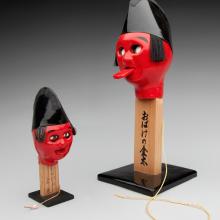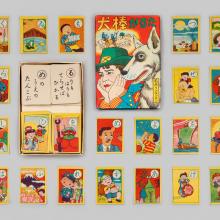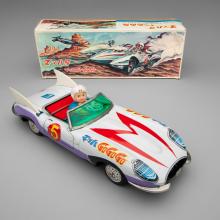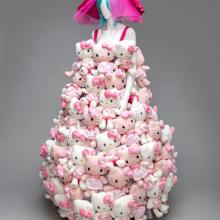Japanese Toys! From Kokeshi to Kaiju
Japanese Toys! From Kokeshi to Kaiju
The Japanese imagination has led to many of the world’s most extraordinary toys. Japanese toys span an unparalleled gamut—from a centuries-long practice of traditional doll making to whimsical folk toys, such as ghostly mechanical kobe figures and papier-mâché guardian dogs. Throughout the prosperous Edo period (1615–1868), many new folk toys originated, including cylindrically shaped, wooden kokeshi dolls, which formed the basis of thriving craft industries. Similar to other folk arts, a toy typically developed through the ingenuity of a single individual or a small group of makers before it spread to other areas and artisans. Such toys reflect Japanese regional customs, legends, history, and locally available materials. Artisans continue to make a great variety of folk toys in Japan. Today, many are sold as souvenirs and collector’s items rather than toys.
During the Meiji period (1868–1912), when Japan opened its doors to the West, the country rapidly transformed into a modern, industrialized nation. At this time, the Japanese began to make toys that emulated their German and American counterparts. Manufacturers made toys from tin, celluloid, and other new materials. As German imports ceased during World War I, the Japanese toy industry flourished. By 1915, Japan offered a variety of toys to Europe and the United States and continued to do so until World War II. Following the war, Japan’s toy industry experienced its golden era, when makers created a kaleidoscope of unique toys for export and home consumption. Classic wind-up and battery-operated toys of the pre- and postwar eras include dancing couples, tinplate cars, and cymbal-clapping monkeys. As Japan continued to prosper in the 1970s, labor costs increased, and fewer export toys were made as many manufacturers shifted their focus to high-tech products.
Japanese movie, television, and manga (comics) inspired legions of iconic character toys. Godzilla, the king of monsters, spawned from the atomic bomb’s aftermath, stormed onto the screen as the premier kaiju or Japanese monster in 1954. Ultraman, a futuristic television series introduced in 1966, featured a superhuman hero who battled a new kaiju each episode. The manga Astro Boy or Mighty Atom, about a child robot, made its debut in 1952 and prompted the first of many animated television programs in the 1960s. Later on, kawaii, which refers to all things cute, became a national obsession. One of the world's most beloved icons, Hello Kitty, created in 1974 by Sanrio, remains as popular as ever.
Japanese Toys! From Kokeshi to Kaiju provides a feast for the eyes and the imagination. This exhibition captures the remarkable evolution of Japanese toys. Kokeshi dolls, menko playing cards, and battery-operated robots are among the quintessential toys on display. Vinyl kaiju figures, Ultraman novelties, and a dress made entirely from plush Hello Kitty dolls are some of the unexpected items on view.
A special thank you to all of the lenders who made this exhibition possible: Boss Robot Hobby, California Academy of Sciences, Chizuko Kuroda, Kalim Winata, Kimono My House, Mark Nagata, Reed Darmon, Rory Yellin, and Sanrio, Inc.
©2013 by the San Francisco Airport Commission. All rights reserved.
















